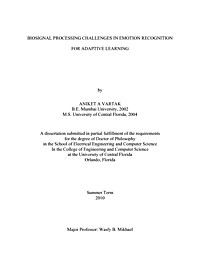
Biosignal processing challenges in emotion recognition for adaptive learning
User-centered computer based learning is an emerging field of interdisciplinary research. Research in diverse areas such as psychology, computer science, neuroscience and signal processing is making contributions to take this field to the next level. Learning systems built using contributions from these fields could be used in actual training and education instead of just laboratory proof-of-concept. One of the important advances in this research is the detection and assessment of the cognitive and emotional state of the learner using such systems. This capability moves development beyond the use of traditional user performance metrics to include system intelligence measures that are based on current theories in neuroscience. These advances are of paramount importance in the success and wide spread use of learning systems that are automated and intelligent. Emotion is considered an important aspect of how learning occurs, and yet estimating it and making adaptive adjustments are not part of most learning systems. In this research we focus on one specific aspect of constructing an adaptive and intelligent learning system, that is, estimation of the emotion of the learner as he/she is using the automated training system. The challenge starts with the definition of the emotion and the utility of it in human life. The next challenge is to measure the co-varying factors of the emotions in a non-invasive way, and find consistent features from these measures that are valid across wide population. In this research we use four physiological sensors that are non-invasive, and establish a methodology of utilizing the data from these sensors using different signal processing tools. A validated set of visual stimuli used worldwide in the research of emotion and attention, called International Affective Picture System (IAPS), is used. A dataset is collected from the sensors in an experiment designed to elicit emotions from these validated visual stimuli. We describe a novel wavelet method to calculate hemispheric asymmetry metric using electroencephalography data. This method is tested against typically used power spectral density method. We show overall improvement in accuracy in classifying specific emotions using the novel method. We also show distinctions between different discrete emotions from the autonomic nervous system activity using electrocardiography, electrodermal activity and pupil diameter changes. Findings from different features from these sensors are used to give guidelines to use each of the individual sensors in the adaptive learning environment.


















